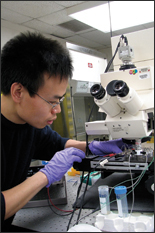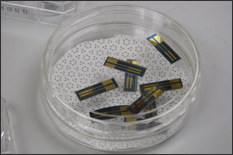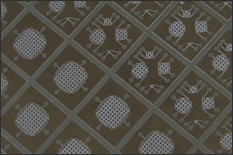U. of Md. Researchers to Develop Device to Revolutionize Drug Research |
|
FOR IMMEDIATE RELEASE
COLLEGE PARK, Md.—A multi-disciplinary group of researchers from the University of Maryland, College Park, and the University of Maryland Biotechnology Institute (UMBI) has won a competitive, $2 million National Science Foundation (NSF) grant to revolutionize the way researchers develop and test pharmaceutical drugs. The group, led by William Bentley, Herbert Rabin Distinguished Professor and chair of the Fischell Department of Bioengineering at the University of Maryland's A. James Clark School of Engineering, plans to build devices that test new drugs using living, human biological components rather than "animal models," thus significantly improving the accuracy and speed of drug development.
Currently, the average drug takes about 10 years and $1 billion in research dollars to reach the market. "The current testing system, involving mice and other animals, doesn't reflect the human body," Bentley said. "This leads to inaccurate results that require additional rounds of testing, dragging out the process for years."
Bentley and colleagues from UMBI, the Maryland NanoCenter, the Institute for Systems Research (ISR) and the Clark School's electrical and computer engineering and materials science and engineering departments, are collaborating to build devices that will allow a drug researcher to input both a drug to be tested and specific human biological components, such as proteins or cells. Such a device makes multiple, simultaneous measurements of how those components respond to the drug, to determine whether the drug is successful. The device thus serves as a research environment that mimics the human body. "It will be an adaptable, multi-purpose toolbox built using microfabrication techniques that are already the industry standard," Bentley said.
Because researchers will add the human biological components to the device after manufacture, the device can have a longer shelf-life, and the same device can be used for a variety of tests. The device, currently the size of an iPod Shuffle, can be made smaller as industry techniques allow for the manufacture of smaller devices. The University of Maryland team is particularly focused on using their device to test drugs that may block cell-to-cell "quorum-sensing," a key process in the development of infections in the body. In quorum-sensing, bacteria cells communicate with each other to form a quorum or group capable of creating an infection. Bentley and his team have already demonstrated that it is possible to interrupt this quorum-sensing ability or to introduce new communication to prevent such infections. Using a drug to interrupt quorum sensing offers an important advantage over using antibiotics, the traditional weapons of choice that battle infections by killing bacteria. A drug that interrupts quorum-sensing will not stimulate the bacteria to evolve and become resistant, as antibiotics do. The grant for "Biofunctionalized Devices—On Chip Signaling and 'Rewiring' Bacterial Cell-Cell Communications" comes under the Emerging Frontiers in Research and Innovation (EFRI) program—the NSF's newest and most competitive—which funds projects involving groups of researchers from at least three different fields and who have a plan to change the way people perform research. The goal of the EFRI program is to encourage researchers to transform the way engineering addresses critical societal problems, according to the NSF. "In biology, it is time-consuming and expensive to generate the multiple forms of evidence needed to arrive at a conclusion," Bentley said. "The team aims to miniaturize and automate this process in a lab-on-a-chip device that enlists the power of microelectronics." These devices will allow multiple samples to be analyzed simultaneously. Each sample will be tested using a series of independent sensors, with each providing unique information about the sample." For example, the device will be able to take electrical, mechanical and optical measurements of biofilm (a coating created by bacteria that is the first sign of an infection). These results, collected in parallel, can then be correlated much faster than with current methods. The researchers are already working with a management board made up of representatives from sanofi pasteur, MedImmune and Bristol-Meyers Squibb. "They help guide us so we are addressing current industry needs," Bentley said. Bentley's colleagues on the project include Greg Payne, director of UMBI's Center for Biosystems Research; Reza Ghodssi, associate professor with the Clark School's electrical and computer engineering department and ISR; and Gary Rubloff, professor with a joint appointment in the Clark School's materials science and engineering department and ISR and director of the Maryland NanoCenter. Helpful Links Related Work About the A. James Clark School of Engineering The Clark School's graduate programs are collectively the fastest rising in the nation. In U.S. News & World Report's annual rating of graduate programs, the school is 15th among public and private programs nationally, 9th among public programs nationally and first among public programs in the mid-Atlantic region. The School offers 13 graduate programs and 12 undergraduate programs, including two degree programs tailored for working professionals and one certification program. The school is home to one of the most vibrant research programs in the country. With major emphasis in key areas such as communications and networking, nanotechnology, bioengineering, reliability engineering, project management, intelligent transportation systems and space robotics, as well as electronic packaging and smart small systems and materials, the Clark School is leading the way toward the next generations of advanced engineering technology. Visit the Clark School homepage at www.eng.umd.edu. About the University of Maryland Biotechnology Institute ###
|
|
||||||||||||||||||||||||||||














